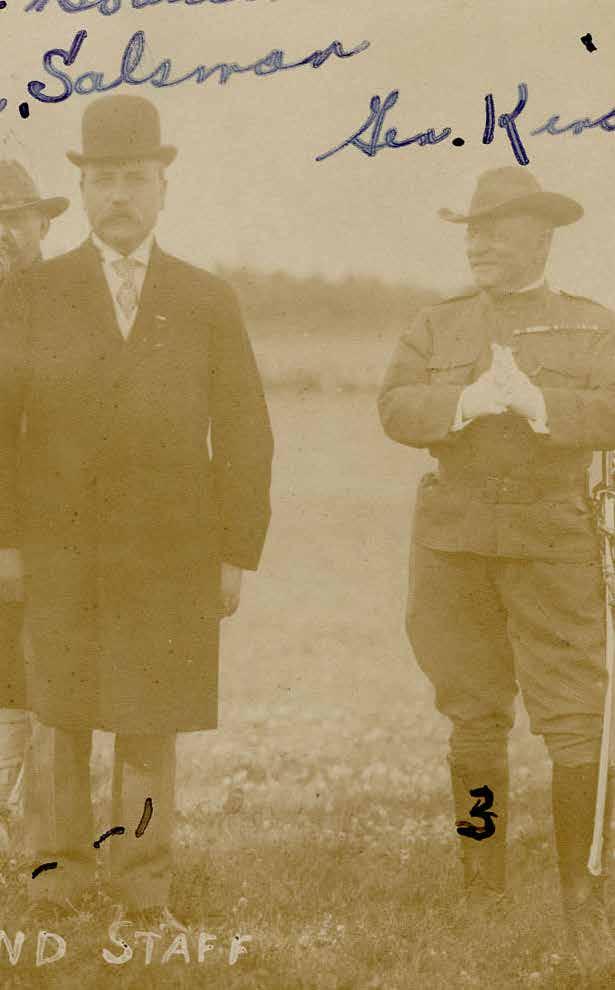
SPRING 2022 1
SPRING 2022 | VOLUME 29: 1
BU G LE THE
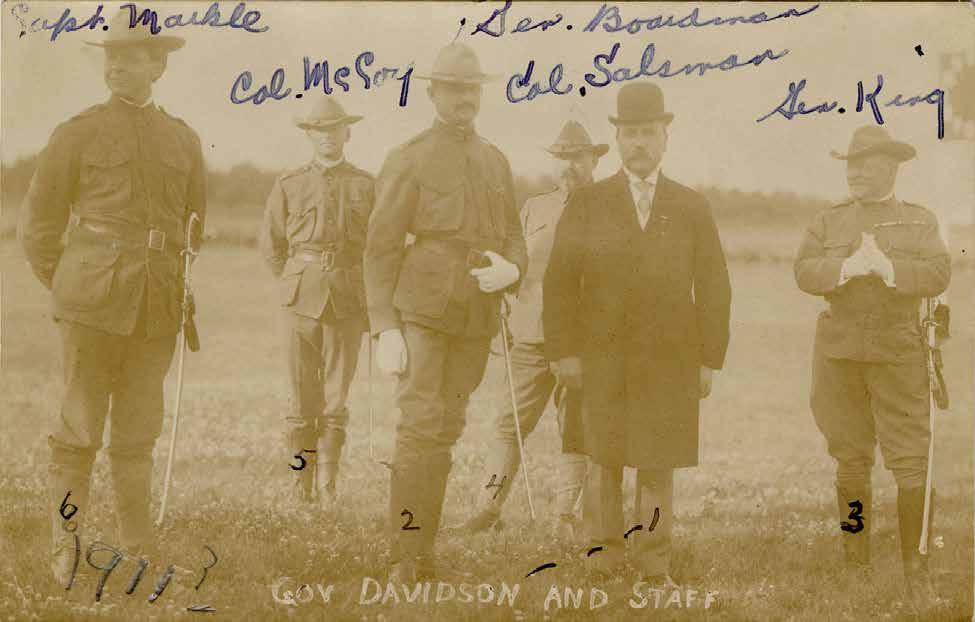
7 | FROM THE SECRETARY 9 | FROM THE DIRECTOR 10-11 | EVERY VETERAN IS A STORY 12-13 | FROM THE COLLECTION 14-17 | MCCOY FAMILY 18-19 | ONE SWEET GIFT 21 | MEET THE STAFF 22-23 | BEHIND THE SCENES 25 | FROM THE FOUNDATION 26 | CALENDAR 27 | THANK YOU DONORS CONTENTS
Photographic postcard of Governor James O. Davidson and his military staff, taken circa 1911. The governor, in the dark coat and bowler hat, is surrounded by Captain Markle, Colonel McCoy, General Boardman, Colonel Salsman and General King, all in uniform. This image was likely taken on a trip to inspect Wisconsin National Guard troops at Camp Douglas. McCoy family collection, WVM Mss 1360 (WVM.1360.061)
MUSEUM STAFF
DIRECTOR
CHRISTOPHER L. KOLAKOWSKI | 608.266.1009
ASSISTANT DIRECTOR
JENNIFER VAN HAAFTEN | 608.261.6802
OPERATIONS ASSISTANT
ELISE MCFARLANE | 608.261.0534
ORAL HISTORIAN
LUKE SPRAGUE | 608.261.0537
CURATOR OF HISTORY
KEVIN HAMPTON | 608.261.5409
PROCESSING ARCHIVIST

BRITTANY STROBEL | 608.800.6958
COLLECTIONS MANAGER
ANDREA HOFFMAN | 608.800.6957
REFERENCE ARCHIVIST
RUSS HORTON | 608.267.1790
REGISTRAR
SARAH KAPELLUSCH | 608.800.6955
CURATOR OF EXHIBITS
GREGORY KRUEGER | 608.261.0541
STORE MANAGER
GREG LAWSON | 608.261.0535
COMMUNICATIONS & MARKETING SPECIALIST


JENNIFER STEVENSON | 608.264.6068
CURATOR OF VETERAN ART
YVETTE PINO | 608.266.1854
EDUCATION SPECIALIST
ERIK WRIGHT | 608.264.7663
COMMENTS & SUBMISSIONS
We welcome your comments and editorial submissions concerning The Bugle. Comments and submissions should be sent to Jennifer Stevenson at Jennifer.Stevenson@dva.wisconsin.gov
THE WISCONSIN
VETERANS MUSEUM
30 WEST MIFFLIN STREET MADISON, WI 53703
ON THE CAPITOL SQUARE 608.267.1799
www.wisvetsmuseum.com
MUSEUM HOURS
Closed Mondays
Tuesday−Saturday 10:00 AM–5:00PM Sunday (April–September) Noon–5:00 PM




RESEARCH CENTER HOURS
By appointment only 608.267.1790
FOUNDATION BOARD OF DIRECTORS
PRESIDENT
DAN CHECKI
VICE PRESIDENT
JOANE MATHEWS
TREASURER
DAN HEILIGER
SECRETARY
TOM HUISMANN
FOUNDATION STAFF
DIRECTORS AT LARGE
JEFF BOUDREAU
ALEJANDRO ARANGO-ESCALANTE
DAN GREENE
WILLIAM F. HUSTAD
TIMOTHY LA SAGE
NATHANIEL T. MILLSAP, JR.
JOSEPH NAYLOR
EXECUTIVE DIRECTOR
JENNIFER CARLSON
608.261.0536
JENNIFER.CARLSON@ WVMFOUNDATION.COM
COLLECTION DONORS
11/13/21–2/11/22
A most sincere thank you to all who donated to our collection from November 2021–February 2022. Thank you for your generosity and support of the Wisconsin Veterans Museum.
Bonnie Benson
K.D. Bradshaw
Joshua Braun
Tom Brodd
Grace Chosy
Linda Christensen
Wayne Darling
Carole DisParti
Patrick Donnelly
Sharon Dosch
Tom Dosch
Join Us Online!
Lynn Duesing
Jill Ellis
Patricia Feirtag
Tim Grover
Mary Groves
Beth Harrington
Benson
Steve Hazell
Robert Koepcke
Susan Kordula
Peggy LeMahieu
Cathy Mais
Charlene McFall
Terrell Morris
Roger Nelson
Elizabeth Overstad
Brian Peters
Karen Ransom
Harris
Larry Reed
David Sharpe
Ann Smiley
Rolly Squire
Jan Stittleburg
Corinne Sturm
Paula Tholl
Dennis Trest
John Walters
Kathy Warnes
Mary Ann Wasick
Joyce Wells
Lois Wiedenhoeft
Dan Wilson
Richard Wolf
Natalie Zoe
MUSEUM MISSION
The mission of the Wisconsin Veterans Museum is to commemorate, acknowledge, and affirm the role of Wisconsin veterans in America’s military past and present
The Bugle is published quarterly for our members and friends through the support of the Wisconsin Veterans Museum Foundation. The Wisconsin Veterans Museum Foundation provides funds for the support of artifact acquisitions, exhibit production, and the development of educational programs.

FROM THE SECRETARY

Greetings. I hope you are staying safe and healthy. A new year means new challenges and new opportunities to tell more veterans' stories.
The Wisconsin Veterans Museum is taking the opportunity this year to highlight the service of veterans representing the diversity of our state.
As you know, the exhibits and items on display are representative of all our veterans from across the length and breadth of our state, and not only just those who come from our major metropolitan areas. Collecting, telling, and sharing those stories from veterans who represent rural areas and each town, city, and region of Wisconsin is key to the mission of our museum.
As this issue is dedicated to emphasizing veteran stories from the La Crosse-Eau Claire area, it seems fitting I should share my story with you here as well.
I grew up in Wilton, Wisconsin, about a 20-minute drive from the VA Hospital in Tomah. I was fortunate to grow up in a family with a strong commitment to serving our country. My grandfather served in the US Army, my father and two oldest brothers in the US Navy, one in the US Air Force, and one brother with the Marines. After the death of my father when I was two years old, my mother became a single parent of seven children, yet she remained committed to her community, country, and service to our veterans.
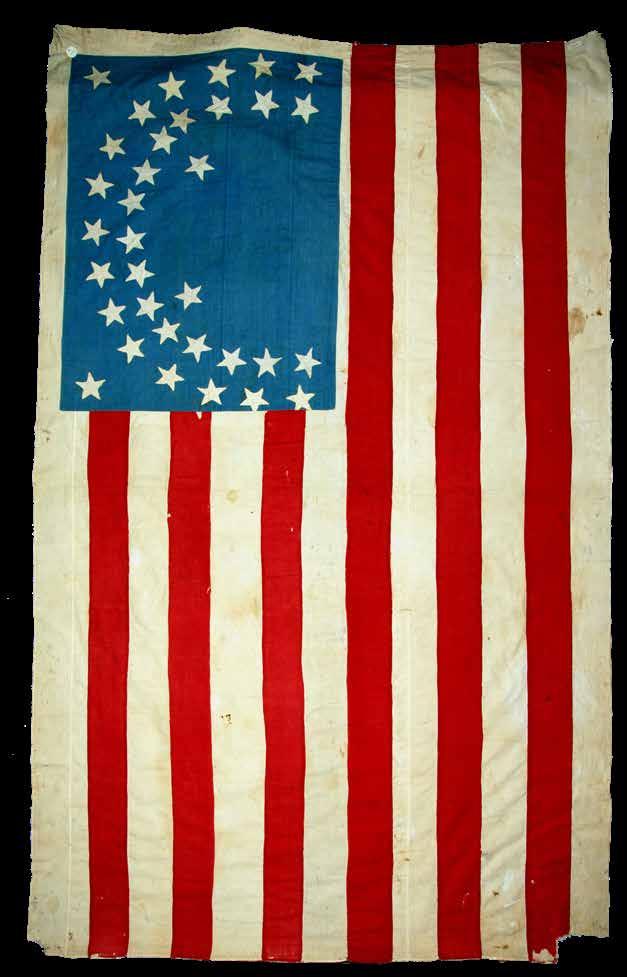
After graduating from UW-La Crosse, I joined the US Navy. I served 28 years while working with all facets of the navy and all military services. As my naval career progressed with subsequent moves, promotions, and duty stations between the Midwest and the East Coast, I maintained my hometown and Wisconsin connections as much as possible.
I’m honored to continue my family’s strong legacy of service to our country that originated from this beautiful corner of Wisconsin. My husband also served in the US Navy. Our oldest son is currently serving in the US Navy. Our youngest is a firefighter. I could not be prouder of my family, just as I’m sure you are of your family and friends who serve.
My appreciation always to our museum’s director Chris Kolakowski, his talented curators, dedicated staff, and the WVM Foundation Board for their commitment to sharing the details of our rich Wisconsin veteran history representing all areas of our state.
If you have not done so yet, I encourage you visit the museum and find stories of our veterans with a personal connection from your region of Wisconsin.
With shared camaraderie,
Mary M. Kolar Secretary, Wisconsin Department of Veterans Affairs

6 SPRING 2022 7
Flag, National, 8th Wisconsin Volunteer Infantry Regiment, Company C, Sewn by Ladies of Eau Claire, V1977.6
FROM THE DIRECTOR
Dear Friends of the Wisconsin Veterans Museum, Greetings! I hope this finds all of you well and safe. Spring is upon us, which means school tours, more visitors, and nicer weather. The staff and I are looking forward to all of it. This issue starts a new approach we’ll be following over the next year and a half. Each Bugle edition will focus on a specific region of Wisconsin, highlighting stories in our collection from that area. We’re based primarily in Madison, but our mission covers the entire Badger State. Our collections show that every part of Wisconsin has its heritage of service, valor, and sacrifice – something every Badger can be proud of. Stay tuned, you’ll see some truly compelling stories.
Early April also marks some important anniversaries for Wisconsin veterans. In 1862, 160 years ago, Badgers fought in the Battle of Shiloh in Tennessee on April 6 and 7; the cannon on display in our museum was captured at that battle and brought back to Madison as a trophy. In 1917, 105 years ago, the United States entered World War I on April 6. In 1942, 80 years ago, Bataan’s defenders surrendered on April 9, including many Wisconsinites, among them a National Guard unit from Janesville. The infamous Bataan Death March began the next day. Last, 50 years ago in 1972 was the Easter Offensive in Vietnam. We are showcasing all these anniversaries in our programming and on our social media, Facebook, Instagram, and Twitter.
Though the museum is back open with some in-person programs, we also continue our extensive online offerings which attract audiences from across the state, nation, and world. These are only possible with the help and support of the Wisconsin Veterans Museum Foundation. I encourage everyone to see what is available on our website.
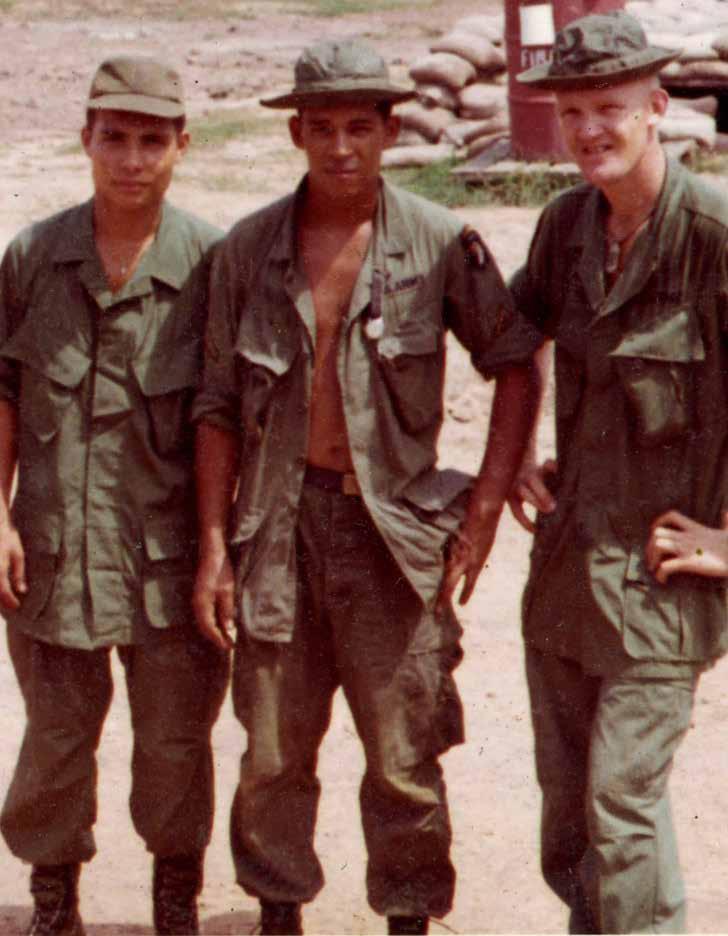
Best wishes to all of you and thank you for your continuing support. See you at the museum soon.
Best,
Chris Kolakowski
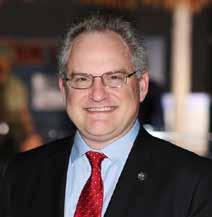
SPRING 2022 9
Vietnam-era image from from the Delbert Hunt Collection, WVM.1649.I002
Timothy Bauer, a Hudson, Wisconsin native, joined the US Navy in 1966. After attending Hospital Corps School and Advanced Orthopedic Technician School, he deployed to Vietnam. He served near I Corps aboard the USS Valley Forge during Operation Brave Armada, performing surgery on wounded American soldiers and Marines. After his discharge, he enlisted into the US Army Reserve, eventually transferring to the US Naval Reserve and rising to the rank of lieutenant.

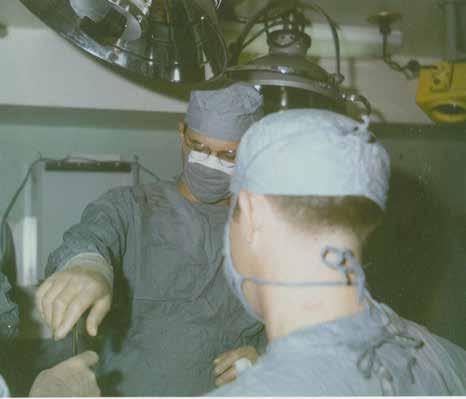
Ida “Becky” Bechtold, a West Salem, Wisconsin native, graduated from nursing school in La Crosse and was head of a surgical clinic and a nursing school faculty member when she joined the US Army Nurse Corps in July 1942. She served as chief nurse at a stateside general hospital before deploying to the Pacific Theater. There, she served as head nurse for General Hospital 44 and participated in the New Guinea and Southern Philippines campaigns. She rose to the rank of lieutenant colonel before returning to civilian life in 1946.
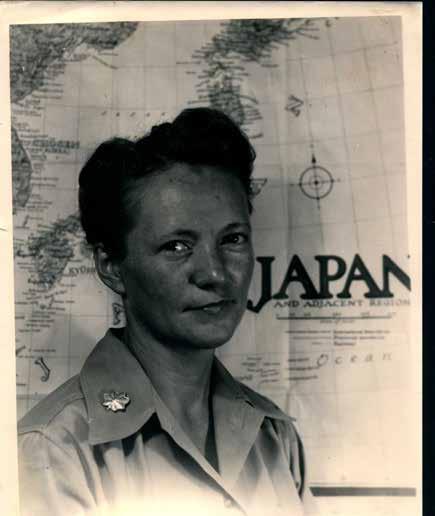

EVERY VETERAN IS A STORY
By: Russ Horton Reference Archivist
Hailed by local papers as one of his “community’s outstanding military men” and “greatest heroes,” Sparta, Wisconsin resident Captain Frank Lyon French earned national recognition for his gallantry in action during the Philippine-American War. As a former local telegraph operator, mail carrier, and postmaster, the Monroe County native was well known in the community and was given a hero’s welcome accordingly upon his return home in April 1901. 120 years later, the Wisconsin Veterans Museum received French’s unusually complete collection, much of which was acquired during his time in the Philippines.
French initially joined the National Guard in 1887 and served in local Company L, 3rd Wisconsin Infantry through the SpanishAmerican War, where he was named captain of the company in September 1898. After his return from Puerto Rico in October and subsequent mustering out in 1899, he accepted a commission as captain of Company H, 34th US Infantry Regiment, entering into two
COLLECTIONS FROM THE
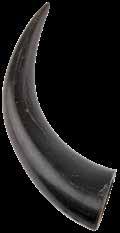

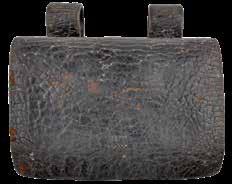

pursuit of insurgent leader Emilio Aguinaldo, the men found evidence relating to the whereabouts of US Navy Lieutenant James Gilmore and crew from the USS Yorktown who had been captured that April. This led to a two-week mission to find and overtake their Filipino captors. Thirty years later, French would be honored with a Silver Star medal for this daring rescue, the citation reading in part: “For gallantry in action in the pursuit of superior forces of the enemy under the Insurgent General Tinio in Northern Luzon, Philippine Islands, December 4-18, 1899, through a most dangerous and difficult country through hardships and exposure, thereby assisting in the liberation of twentytwo American prisoners, Dec. 18, 1899.”
Upon his return, Captain French received a gold medal from the state of Wisconsin and a gold sword and scabbard from the citizens of Sparta. President McKinley also offered him a commission in the regular army, but he declined, preferring instead to return to civilian life and work locally as a railroad agent. French did, however, remain a member of the state rifle team, at one point winning a revolver from General Charles King due to his skill. He was also active in the Wisconsin State Guard during World War I as well as serving as commander of the local Spanish American War Veterans post. He passed away in Sparta in
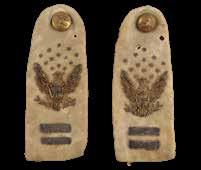
 By: Andrea Hoffman Collections Manager
By: Andrea Hoffman Collections Manager
12 13
WHO ARE THE
VE TERANS IN YOUR NEIGHBORHOOD?
By:
The west-central area of Wisconsin—from Crawford County up to Barron and from the St. Croix River across to the Chippewa River Valley—is home to many important stories from Wisconsin’s military history that are interwoven into the identity of these communities and state history. Digging deeper into the stories from this region, we sometimes find connections that we didn’t know existed: why a landmark bears a certain name or a family name that is so familiar because they’ve been part of our vocabulary for generations.
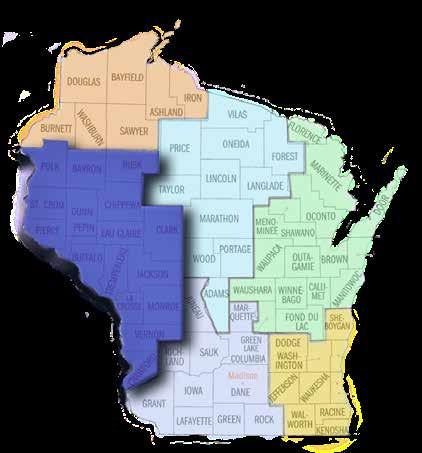
One of the most familiar names from this area of Wisconsin is McCoy, namesake of Fort McCoy located between Tomah and Sparta. Who are the McCoys? Robert Bruce McCoy was a veteran of the Spanish-American War, the commander of the 128 th Infantry Regiment in World War I, and the commander of the entire 32 nd Division. In 1909, he acquired the land that became the landmark military installation we know today. Prior to its current title, Fort McCoy was known by several names including the Sparta Maneuver Tract, the Military Reservation, and Camp Robinson after local Sparta Civil War veteran and Iron Brigade Commander William W. Robinson . Not until 1926 was the installation officially named Camp McCoy in honor of Major General Robert Bruce McCoy who died earlier that year.
Although the army installation is named after a single McCoy, the family name has a long legacy of military service in Wisconsin. Stay with us here as we explain the lineage. The McCoy’s naming scheme is the bane of every genealogist’s existence. Robert Bruce McCoy descended from a line of veterans from the Revolution through the Civil War. Subsequent generations continued that legacy. Of Robert Bruce’s seven children, all six boys served in the military. One of the sons that served with him in the Mexican Border Expedition and WWI, Robert Charles , followed more closely in his father’s footsteps
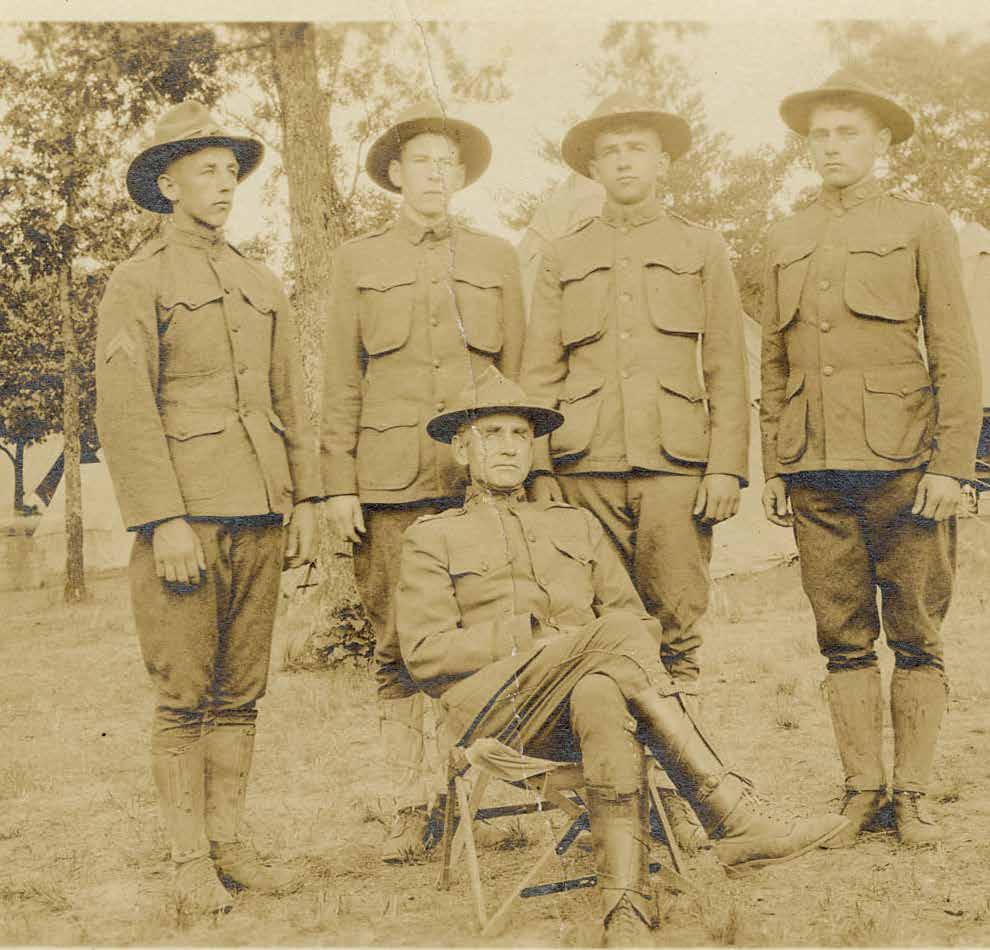
15
John McCoy 1752-? Revolutionary War Jesse McCoy 1800-1871 War of 1812 Bruce Elijah McCoy 1829-1925 43rd WIS INF Civil War Robert Bruce McCoy 1867-1926 SPAN AM, Mexico, WWI Malcom Clark McCoy 1895-1917 Mexico, WWI Bruce Riege McCoy 1986-1972 Mexico, WWI, WWII Robert Charles McCoy 1898-1992 Mexico, WWI, WWII Harold Doesch McCoy 1900-1992 WWI, WWII Douglas D. McCoy 1909-1983 WWII Robert Bruce McCoy 1927-2010 WWII Don Stuart McCoy 1931-1998 Military Service
Kevin Hampton & Greg Lawson
Robert
B.
McCoy with his sons in 1917 with an overlay of the partial family tree. Robert C. is second from right. WVM.1360.I062
Did You Know? – Camp McCoy not only was a training camp during WWII, but it also served as a Prisoner of War camp. The camp held about 5,000 German, 3,500 Japanese, and 500 other Asian nationalities POWs. This is the sign that was used to mark the gate for Prisoner of War Camp #32 at Camp McCoy during WWII. V1998.15
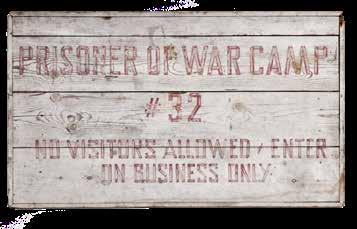
and eventually served as commander of the 128 th Infantry Regiment in the beginning of World War II. After the death of General Robert Bruce in 1926, not only was Camp (later ‘Fort’) McCoy named in his honor, but Robert C. named his son after his father as well. That Robert Bruce continued the family legacy with service in World War II alongside his father.
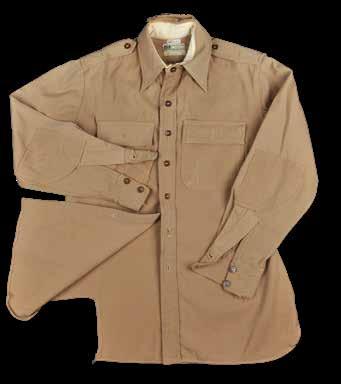
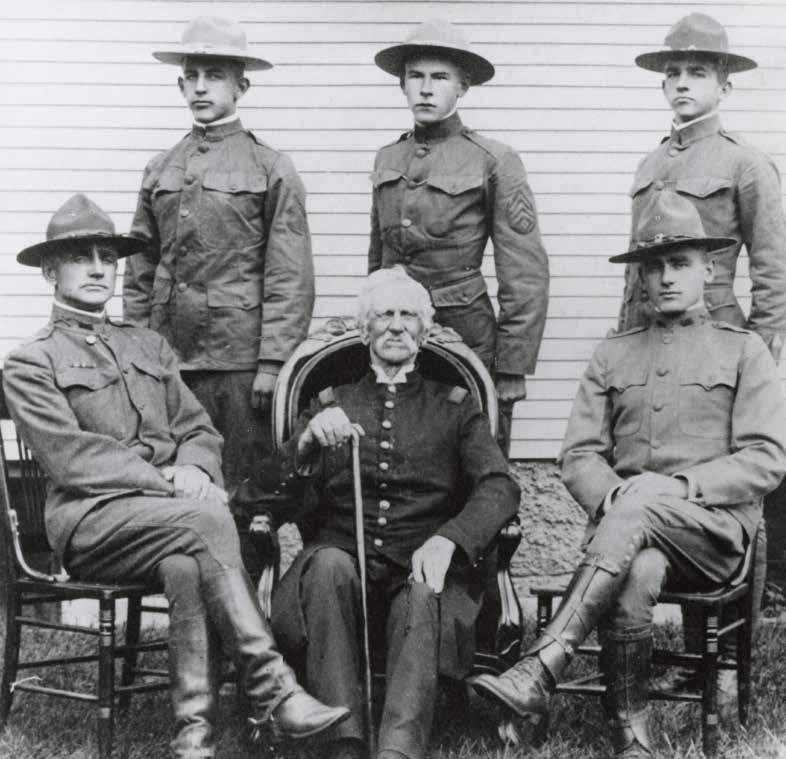
Of course, not all stories of service can be immortalized as the namesake of local landmarks, and this region certainly has its fair share of noteworthy stories and names, though many have been lost to history and aren’t nearly as well known as the McCoys of Fort McCoy’ That anonymity doesn’t make these people any less worthy of remembrance, however. In fact, this region of the state can boast it is the home of at least eight Medal of Honor recipients: Civil War veterans Richard Cosgriff and Horace Ellis of Chippewa Falls, Philippine War veteran Edward Lyon of Hixton, Korean War veteran Stanley Christenson of Mindoro, and Philippine War veteran Hugh McGrath of Eau Claire are some of the lesser known.
Cosgriff volunteered to take a bridge at the end of the Civil War where he rode past two lines of enemy trenches and captured a Confederate flag-bearer in 1865. Ellis, as a member of the 7 th Wisconsin, received his medal for action at the Battle of Globe Tavern in 1864 by capturing the flag-bearer and officers of a Mississippi
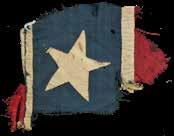
regiment. Lyon, while in the Philippines in 1899, took a position from an enemy of overwhelming force, while McGrath, also in the Philippines in 1899, secured an enemy entrenchment in the face of enemy fire after swimming the San Juan River. Christenson defended his platoon in Korea giving them time to prepare defenses under an enemy attack at the cost of his own life.
These are just a small sample of the thousands of stories of service and
sacrifice that come from this region of Wisconsin. As we go about our daily lives, it’s important to remember that our local history is all around: the namesake of a park, a street, VFW and American Legion post, or a local family business. Next time you see a name you don’t recognize on a stroll through your neighborhood we hope you’ll be inspired to dig deeper to understand the foundations of our communities and the people who built them. That rich history is yours to discover.

16 SPRING 2022 17
During the Battle of Buna in 1942, Robert C. McCoy had to cut out segments from the tails of his shirt to patch holes in the sleeves due to the terrible jungle conditions and constant combat. V2011.43.74
This belt was collected by Robert C. McCoy during World War I and brought back as a souvenir. It is currently on display in our temporary exhibit "Souvenirs of Service." V2011.43.54
Souvenir fragment of the 16th Mississippi Infantry flag captured by Horace Ellis of Chippewa Falls during the Battle of Globe Tavern, 1864. V1999.1.376
Civil War veteran Bruce Elijah McCoy (seated, center) with his son and grandsons that served in WWI. Robert Bruce McCoy (namesake of Fort McCoy) is seated on the left. Robert C. McCoy is standing on the left. WVM.1360.I014
ONE SWEET GIFT
Granville G. Sweet, who went by G.G. or Fritz, was a highly decorated Marine Corps veteran of World War II and Korea when he settled in Eau Claire, Wisconsin in the late 1950s. He purchased a McDonald’s franchise. Sweet quickly became a prominent businessman who cared deeply about his community, including the young people from the area who served in the military during the Vietnam War.
As a veteran, Sweet understood how difficult it could be to serve far away from home and to miss familiar faces and places. He also remembered how thrilling it had been during his service to receive letters from family and friends, and news from home that included familiar names and places. In 1967, he decided to offer a free subscription for the local newspaper to any Eau Claire or Chippewa Falls area resident serving overseas in the military.

This simple act of kindness resulted in a barrage of thank you letters. The first letters came from Eau Claire and Chippewa Falls residents,
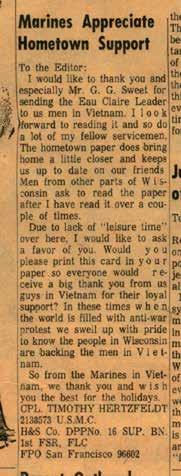
including the parents of service people, who greatly appreciated the fact that someone was not only thinking about the young men and women serving overseas, but also taking action to help them. These letters reveal a sense of community in the area, and the care and concern for young residents.

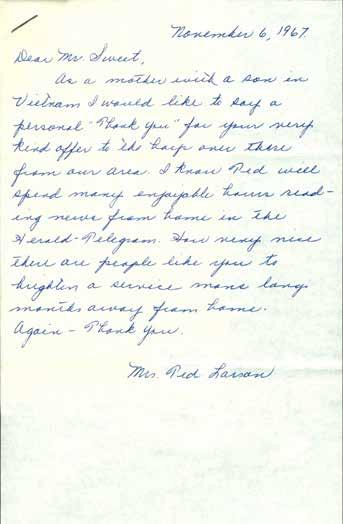
Later, Sweet began receiving letters from the soldiers and sailors themselves. They thanked Sweet with sentiments like, “I appreciate hearing from home and the best way is from your Mother and from the newspaper,” and, “It is one of the best gifts I have received during my tour here in Viet Nam.” These thank you letters show the vital importance of feeling
By: Russ Horton Reference Archivist
connected to familiar names and places while serving overseas. The writers often wrote a paragraph or two describing their experiences during the war, including their unit, station, and length of tour.
While most letter collections at the Wisconsin Veterans Museum provide insight into the service of an individual veteran, the letters in the Granville Sweet collection are different. They provide a unique look at the Vietnam service of the Eau Claire and Chippewa Fall region of Wisconsin, as well as an example of local pride and desire to help men and women serving in the military.

SPRING 2022 19
Vintage MILITARY T-Shirts
$24.95
Sizes Small-2XL
As readers and followers of the museum, you may recognize names in bylines issue after issue. We thought sharing a bit about the staff that researches and cares for the stories and artifacts of Wisconsin veterans would be of interest to our readers. For this issue we begin with the staff member charged with the most ancient of storytelling techniques, Oral Historian Luke Sprague from Thorp, Wisconsin. Tucked away in a third-floor office surrounded by monitors and audio equipment you’ll find Luke working to preserve the stories of our veterans in their own words.
A veteran himself, Luke graduated with a BS in cartography from UW-Stevens Point as a commissioned second lieutenant in the United States Army. He served for four years on active duty in Korea, Japan, and Washington and was honorably discharged at the rank of captain. He later received his master’s in military history at Norwich University.
the Library of Congress, Witness to War, and the World War II Museum. Processing one oral history takes a minimum of 66 hours from start to finish. With the time involved one would think that Sprague would know minute details of the narrators in the collection. This is not the case.
As Sprague says, “We do not get a lot of time to imbibe, and simmer, and stew in the content. There isn’t as much time to get to know these people as we would like. A lot of the time we are just running and gunning. We hand it off to someone who gets to do that.” You will see the results of his team’s work in the archival collection, museum exhibits, on our blogs, and in publications.
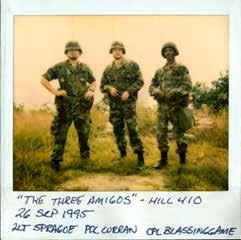
Available now in the Wisconsin Veterans Museum Gift Store: Camp McCoy T-Shirts
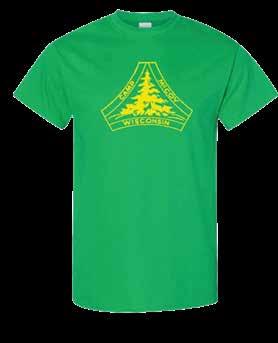

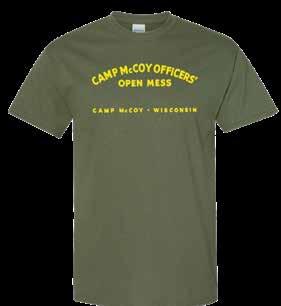


The designs of these Camp McCoy shirts are based on object from the collection of John D. Winner of Madison, a veteran of World War II and Korea. The shirts are made of 100% pre-shrunk cotton which means they are lightweight, comfortable, and perfect for a day outside in the sun. We’ve had the shirts printed in Madison because we love to support local businesses as much as you do. Summer will be here before you know it, get your shirts and be a retro-fashion icon.
Store.WisVetsMuseum.com
He likens his service experiences to the work staff does at the museum saying, “It was an overall positive thing, but it’s a lot of learning on the fly. It’s like here, there are leadership challenges, it’s how you deal with them, how you adjust, and how you work through them that influences an outcome.”
Sprague cares for the oral history collection at the Wisconsin Veterans Museum which is the fourth largest veteran oral history program in the nation, surpassed only by
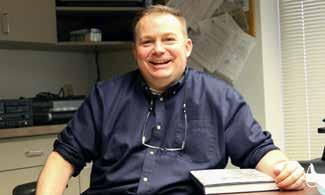
Can Luke pick just one favorite narrator? He says, “Each person is kind of like a special cookie. They each have their own little flavors and each one is different. There are so many that stand out and they are all for different reasons. They may be stories of survival, endurance, depression or repression, escape, just all kinds. So it’s really hard to pick one.”
What Sprague wants the public to know about his work is this, “There are incredible stories available, and they are available to them and if they are interested, they should check it out.”
MUSEUM STAFF MEET THE
BEHIND THE SCENES
ORAL HISTORY DEPARTMENT
Preparation
The pre-interview stage is perhaps the most important part to the creation of a quality interview. It is during this time that the interviewer establishes trust with the veteran. During the pre-interview call, the interviewer addresses the veteran’s concerns and asks questions that assist in their research about the veteran.
When most people hear the words oral history, they usually picture two people sitting at a table conducting an interview. Not that this is inaccurate, but it is just one part of a published oral history. At the Wisconsin Veterans Museum (WVM), an interview averages a little more than one and a half hours in length, with the complete oral history lifecycle from first contact to catalog completion averaging 66 hours total for each interview. To better grasp why this amount of work is necessary, this article looks at the five major parts of the oral history lifecycle preparation, interviewing, preservation, access, and cataloging.
Interviewing
At WVM, we train our interviewers to capture the fresh real-world experiences of veterans. The interviewer best accomplishes this by knowing their veteran’s history, being an active-respectful listener, and using a structured interview guide. Preparation is key to a strong interview.
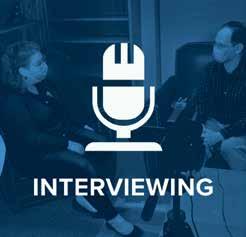

Preservation

Following the interview, a master file is created for each oral history and stored in a fireproof safe. Original recording metadata are created, and the media stored offsite at the State Archive Preservation Facility. Digital preservation masters are created and sent over the network to a preservation server at King, Wisconsin, with additional masters stored at the WVM Research Center.
Access

Today, publication means online access to oral history interviews except where restricted or prevented by copyright issues. We improve the public’s access to interviews using biographical sketches, summaries, transcripts, and exhibits. Also, you can view or listen to interviews at the WVM Research Center by scheduling an appointment.
Cataloging

The Oral History Team makes the interview publicly available on two different searchable databases: Pastperfect and WorldCat.org. As a team, we generate the original metadata, do the data entry, format the data, and then check for errors and standards compliance in each database. At the Wisconsin Veterans Museum, we have one of the largest veteran oral history programs in the United States. But the reality of having a successful oral history program does often result in a backlog of interviews.
Volunteer
We need your help. We are looking for volunteers to help with those tasks listed in this article. Please contact Luke Sprague directly at luke.sprague@dva.wisconsin.gov or call (608) 261-0537 to learn more.
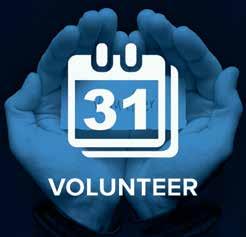

22 SPRING 2022 23
FOUNDATION PRESIDENT

The last several months have seen developments important for our nation, our Wisconsin veterans, and our foundation. As we watch dangerous international events unfold, we are reminded of the critical role our military plays in the defense of our freedom. We are reassured by the fact the women and men who choose the hardships of a career in uniform are on guard and ready for any eventuality. Current events reinforce the Wisconsin Veteran Museum Boards commitment to support the capital campaign to build a new expanded museum. I would like to share thoughts on two recent events that brought the point home to me.
My wife Adriana and I were honored to be invited to Central Command headquarters by General McKenzie for Colonel John Hall’s retirement ceremony on February 25th. There I met many men, women, and their spouses, who have spent the last 20 years in uniform. What struck me most was that for their entire careers we have been at war. I met a recently retired Marine colonel. He was a firefighter in New York City and a first responder to the World Trade Center attack. He then joined the corps and served in Iraq and Afghanistan, constantly in harm’s way for the next 20 years. I spoke with one general’s wife who reflected on the constant family separations as he moved from command to command. I shared a meal with a colonel from Nutley, New Jersey who spoke of the comradery she enjoyed with her service partners and would miss as she plans to end her career. We left the event with a renewed and deeper appreciation for what service members and their families give up doing the job they do. In addition, I was impressed by the fact that they ask for nothing in return which brings me to my second point.

Governor Tony Evers signed an executive order in February to create a Blue-Ribbon Commission on Veteran Opportunity to support those who have served our country in uniform. The governor expressed his concern and backed it with actions designed to help those veterans who are suffering or struggling with the challenges of returning to civilian life.
Evers said, “This is a moral issue. Our nation’s veterans have given so much in the service of our country…The increased isolation, stress, and economic uncertainty over the last couple of years has disproportionately affected Wisconsin veterans…”
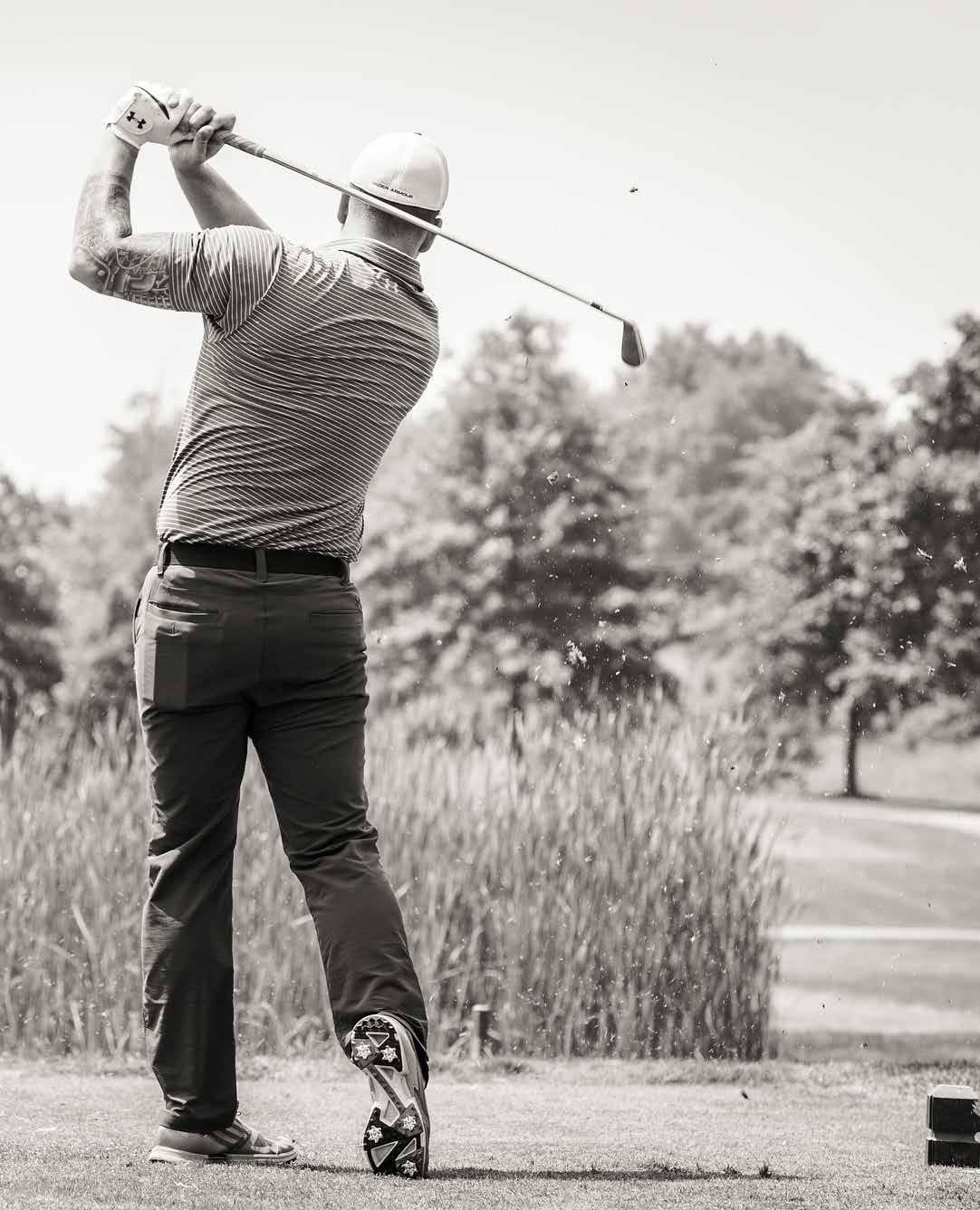
The governor’s sentiments are well founded and prescient. If we consider that we have been at war for the last 20 years, and the toll that must take on those who have had to fight those wars, we can understand the challenges our veterans face when they return to civilian life. However, the problem cannot be fully embraced by our citizens if we do not have a means to understand what I witnessed at Central Command and what Governor Evers eloquently expressed in his remarks.
Our museum offers the venue for our citizens to understand and appreciate what our veterans have done. They do not look to be thanked or praised for their service. Veterans do want our citizens to understand what it takes to keep our freedoms at a time when they are being challenged around the world. Further, we do appreciate the actions taken independently by our governor to help those who find the transition to civilian life difficult. His Blue-Ribbon Commission is a significant step forward to help returning veterans with jobs, housing, education, and health issues.
Let me close by congratulating Colonel and Mrs. Hall on your retirement from active duty and thanking Governor Evers for recognizing the need and taking action to support our veterans.
In gratitude,
 Daniel Checki, Foundation Board President
Daniel Checki, Foundation Board President
SPRING 2022 25
OUTING 18th GOLF OUTING JULY 11, 2022 9 AM-5:30 PM FOUR-PERSON SCRAMBLE • Golf Ball Toss • Putting Contest • Prizes for hole-in-one • Prize Drawing Contest REGISTER BEFORE JUNE 10TH $125 INDIVIDUAL/$500 FOURSOME REGISTER AFTER JUNE 10TH $150 INDIVIDUAL/$600 FOURSOME REGISTRATION OPENS ONLINE MONDAY, APRIL 11TH To become a sponsor, contact: Jen Carlson at Jennifer.Carlson@wvmfoundation.com or call (608)261-0536
GOLF
FROM THE
Pictured from left to right: Heidi Hall, Colonel (Ret) John Hall, Adriana Mateus, Dan Checki and General Kenneth McKenzie.
THE WISCONSIN VETERANS MUSEUM 30 WEST MIFFLIN STREET MADISON, WI 53703 CALL 608.261.0536 or JOIN ONLINE at WWW.WISVETSMUSEUM.COM Click on Join | Give GIVE the GIFT of MEMBERSHIP Today!

























 By: Andrea Hoffman Collections Manager
By: Andrea Hoffman Collections Manager




























